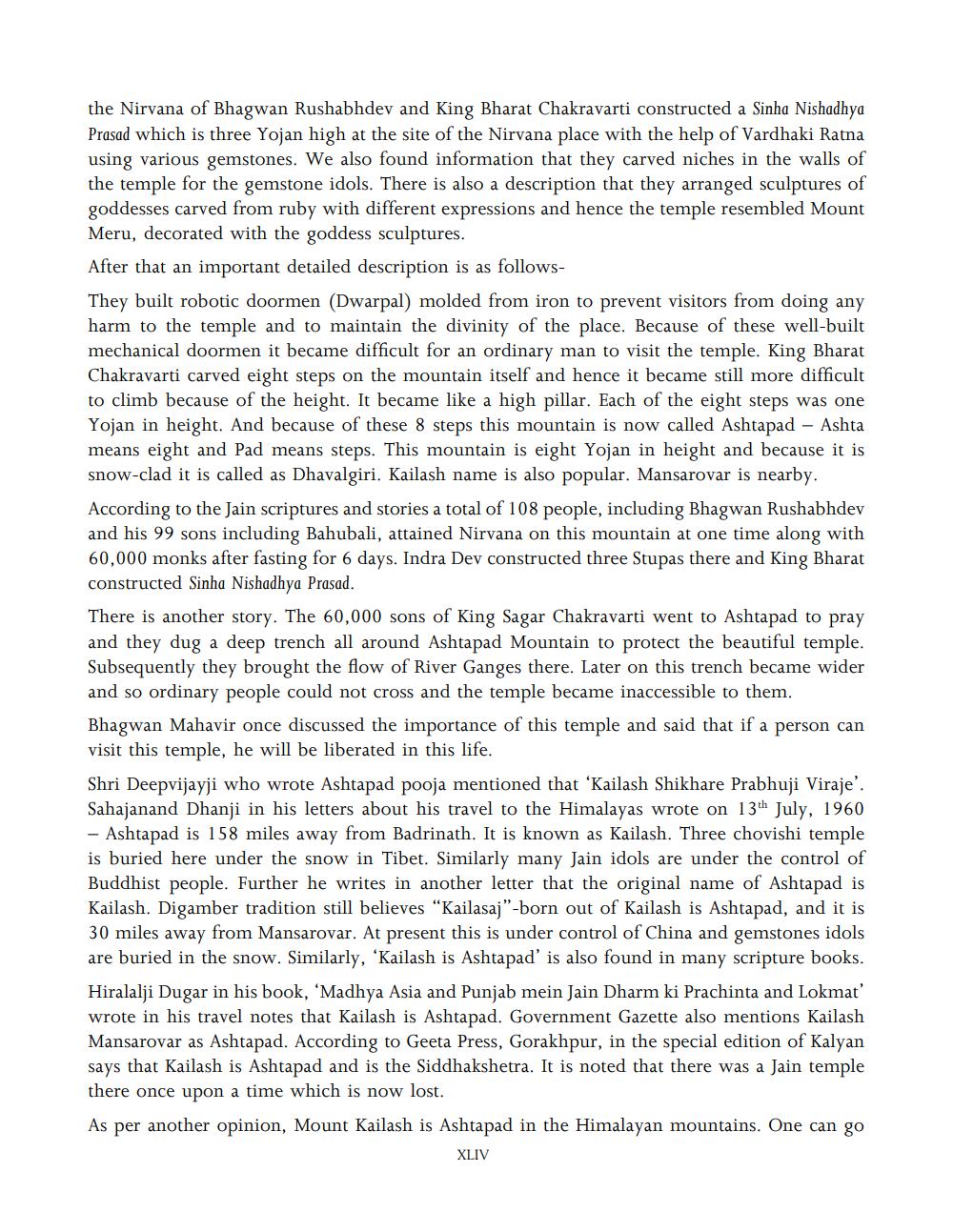________________
the Nirvana of Bhagwan Rushabhdev and King Bharat Chakravarti constructed a Sinha Nishadhya Prasad which is three Yojan high at the site of the Nirvana place with the help of Vardhaki Ratna using various gemstones. We also found information that they carved niches in the walls of the temple for the gemstone idols. There is also a description that they arranged sculptures of goddesses carved from ruby with different expressions and hence the temple resembled Mount Meru, decorated with the goddess sculptures. After that an important detailed description is as followsThey built robotic doormen (Dwarpal) molded from iron to prevent visitors from doing any harm to the temple and to maintain the divinity of the place. Because of these well-built mechanical doormen it became difficult for an ordinary man to visit the temple. King Bharat Chakravarti carved eight steps on the mountain itself and hence it became still more difficult to climb because of the height. It became like a high pillar. Each of the eight steps was one Yojan in height. And because of these 8 steps this mountain is now called Ashtapad - Ashta means eight and Dad means steps. This mountain is eight Yojan in height and because it is snow-clad it is called as Dhavalgiri. Kailash name is also popular. Mansarovar is nearby. According to the Jain scriptures and stories a total of 108 people, including Bhagwan Rushabhdev and his 99 sons including Bahubali, attained Nirvana on this mountain at one time along with 60,000 monks after fasting for 6 days. Indra Dev constructed three Stupas there and King Bharat constructed Sinha Nishadhya Prasad. There is another story. The 60,000 sons of King Sagar Chakravarti went to Ashtapad to pray and they dug a deep trench all around Ashtapad Mountain to protect the beautiful temple. Subsequently they brought the flow of River Ganges there. Later on this trench became wider and so ordinary people could not cross and the temple became inaccessible to them. Bhagwan Mahavir once discussed the importance of this temple and said that if a person can visit this temple, he will be liberated in this life. Shri Deepvijayji who wrote Ashtapad pooja mentioned that 'Kailash Shikhare Prabhuji Viraje'. Sahajanand Dhanji in his letters about his travel to the Himalayas wrote on 13th July, 1960 - Ashtapad is 158 miles away from Badrinath. It is known as Kailash. Three chovishi temple is buried here under the snow in Tibet. Similarly many Jain idols are under the control of Buddhist people. Further he writes in another letter that the original name of Ashtapad is Kailash. Digamber tradition still believes “Kailasaj"-born out of Kailash is Ashtapad, and it is 30 miles away from Mansarovar. At present this is under control of China and gemstones idols are buried in the snow. Similarly, 'Kailash is Ashtapad' is also found in many scripture books. Hiralalji Dugar in his book, 'Madhya Asia and Punjab mein Jain Dharm ki Prachinta and Lokmat' wrote in his travel notes that Kailash is Ashtapad. Government Gazette also mentions Kailash Mansarovar as Ashtapad. According to Geeta Press, Gorakhpur, in the special edition of Kalyan says that Kailash is Ashtapad and is the Siddhakshetra. It is noted that there was a Jain temple there once upon a time which is now lost. As per another opinion, Mount Kailash is Ashtapad in the Himalayan mountains. One can go
XLIV




